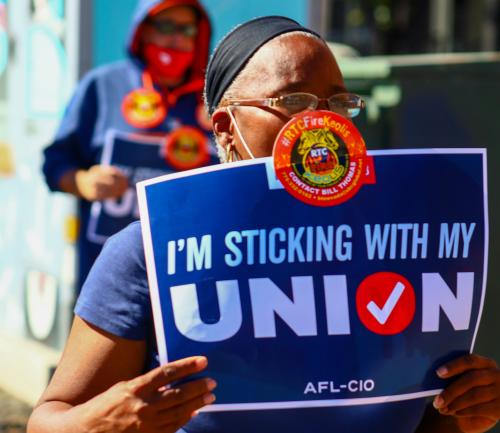Around 40 companies had compensation plans rejected.
The results are in. Given the opportunity to register their opinion for the first time, a majority of shareholders in at least 39 companies rejected executive compensation plans. Another 35 companies squeaked by with between 50 percent and 60 percent support, which according to David Eaton, director of global compensation analysis at Glass Lewis, is ‘pretty close to failing’.
These 74 companies are now left with the vexing question: what should they do about it? ‘If they sit there and do nothing, the level of opposition will start to grow,’ says Robin Ferracone, executive chair of compensation consulting firm Farient Advisors. ‘And if they just let this fester, they’ll be in the spotlight in a negative way on a consistent basis. That creates reputational damage, and could even have a depressive effect on the stock price.’
A handful of companies, including Beazer Homes, Jacobs Engineering, KeyCorp and Occidental Petroleum, are already feeling the heat – shareholders have filed lawsuits after directors went ahead and awarded the pay packages that investors had rejected. And if that’s not enough to prod directors into action before next year, leading proxy advisory firms are vowing to give them another incentive.
Institutional Shareholder Services (ISS) will apply a concept it calls ‘yellow card, red card’ to company directors, explains Patrick McGurn, executive director at the proxy advisory behemoth. This is based on the practice in international football competitions whereby referees issue rule-breaking players with a yellow card as a warning to let them know that any further transgressions will be penalized with a red card and expulsion from the game.
‘Year one is yellow – the advisory vote [say on pay],’ McGurn says. ‘Year two is red. If there are unresolved contentious issues remaining from year one, there’ll be a ‘no’ vote on directors.’ He continues: ‘Where is the ‘red zone’? That’s the big off-season question for our investor clients. In our client survey, we’ll ask point-blank about where our clients want us to draw the line. Fifty percent is obvious, but what about 45? 40? Lower? I’m guessing our clients won’t want to draw the line at 20 percent. We’ll set out guidelines in November.’
Eaton says his company is also likely to ‘hold the compensation committee members, or at least the chairman, accountable for not addressing these issues. If we think it necessary we will recommend against votes on compensation committee members.’
Defining the problem
So what can these companies do to satisfy their shareholders? Before taking any action, corporate governance experts, proxy advisory firms and compliance attorneys all suggest that corporate secretaries and boards get out and speak with shareholders to make sure they understand the root of the problem.
‘Good engagement takes different forms,’ McGurn says. ‘Some people go the wholesale route, with communications and surveys to try and get an idea about what institutional investors are thinking. Others do roadshows, some telephonically. There are a thousand different ways to facilitate the process, but it’s critical to get an early start.’
Peggy Foran, chief governance officer and corporate secretary at Prudential, says her board has established a dedicated compensation committee email address and actively seeks electronic queries on pay matters or anything else relating to the board’s work. Last year, the company received close to 3,000 such emails.
Prudential regularly sends board members and representatives on engagement exercises to places where ‘we know our investors are’, and also invites institutional investors in for meetings with management and board members to solicit feedback. ‘All that information goes to the board so that the board gets a little bit of what’s on investors’ minds,’ Foran says. ‘It’s kind of like a canary in a coalmine.’
Patrick Quick, a corporate governance specialist at Foley & Lardner, notes that ‘what went wrong will vary from company to company, and you have to identify the problem and work out how to address it.’ He notes that there are advantages to such engagement that go beyond just vote counting – reaching out to larger shareholders will not only provide valuable information but will also ‘show an openness to communicate and have a dialogue with shareholders, which will get you some brownie points.’
Nor are shareholders the only ones who boards should be talking to, says Kimberly Gladman, director of research at GovernanceMetrics International (GMI).
She recommends that board members sit down with smart, trusted friends and family who know nothing about executive compensation and try to explain the CEO’s compensation package and policy in plain English.
‘See what reaction you get from a lay person you trust,’ Gladman says. ‘When you are on a comp committee or you get on a board, it’s easy to get into this bubble where it starts to seem very normal to throw around millions of dollars for each element of compensation. You can lose touch.’
Jim Barrall, global chair of the benefits and compensation practice at Latham & Watkins, says that in some cases dialogue may help convince investors that they should support the proposed compensation practices, especially if the company can make the point that there are problems with the way ISS determines company performance and CEO pay.
‘About 100 companies filed SEC responses challenging ISS and Glass Lewis recommendations on pay for performance and other pay issues,’ he says. ‘Companies should review their performance and pay, examine how ISS looks at them and then reach out to their shareholders – explain to them how their pay is aligned with performance and why ISS has it wrong.’
Problems easy to see
Though communication and clarity are essential, many companies probably already have a good idea why their plans were voted down. Some observers who follow compensation say the reasons are usually apparent.
‘A cursory look at the companies that got ‘no’ votes – and there are very few – shows that in a lot of cases there just isn’t pay for performance,’ says Amy Borrus, deputy director of the Council of Institutional Investors. ‘A lot of these companies have had poor returns over multiple years at the same time that executive pay has shot up.’
ISS’s McGurn agrees, but with a caveat. ISS, he notes, recommended ‘no’ votes for ‘a couple hundred’ companies based on pay for performance, but the vast majority saw their plans approved anyway.
For those that didn’t, ‘the early studies show that most of the investors were voting their pocketbooks,’ he says. ‘Most of the companies showed not just poor but in many instances horrendous shareholder returns over the last three years. One of them had a negative 50 percent shareholder return.’
Taking action
Some companies are already taking action in response to the ‘no’ votes. Houston-based Helix Energy Solutions, for instance, has already issued an 8K that outlines areas where the company is considering making changes, including implementing clear performance metrics tied to bonuses and long-term incentive pay.
There are other ways companies can show they take the vote seriously. Some companies, says Quick, could respond by ‘sacrificing someone’.
‘They could say, We are responding to this by changing our chair, or rotating our committee members,’ he says. ‘They could also fire their independent consultant and try to use that as a story about how they responded to shareholders. Ultimately what they want to do is look responsive in a meaningful way so that the bad vote this year doesn’t negatively affect them next year.’
Gladman lists a number of areas that could further aggravate investors already steamed about bad performance. Though some companies might argue that their executive compensation is comparable to that of other US firms, she notes, many shareholders won’t care because they are invested internationally.
‘US pay packages are often very different from those in the rest of the world – much more favorable to the executive,’ she says. ‘Investors aren’t just thinking in an American context – they want to compare your practices to a global standard.’
GMI recently launched what it calls an ‘executive scorecard’ that rates the pay packages of S&P 500 companies on 10 criteria developed in consultation with its clients, mainly large institutional investors, pension funds, mutual funds and other investors with a longer-term orientation. Among the practices that ‘really irritate’ these clients are ratios between CEO pay and the medium pay of the other named executive officers.
‘Star systems are hard to believe,’ Gladman says. ‘People ask, Why is that person so much more valuable than anyone else on the team? Either you are overpaying or you have a key person risk because the rest of the team is maybe not that strong. Either way, it’s not a good situation.’
‘It’s definitely damaging, but it’s also an opportunity for companies to address these issues,’ says Eaton. ‘It’s a chance to demonstrate how the board operates – how it listens to shareholders and adjusts its plans accordingly.’








